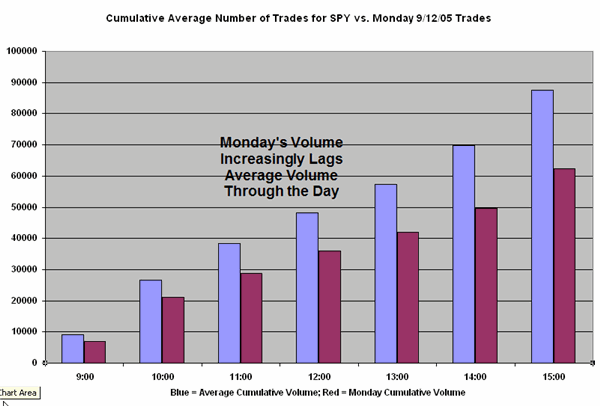Do you love big intraday swings? Find them with this indicator
What do you do if you’re a batter and the pitcher throws around you, well out
of the strike zone? Do you swing wildly, trying to hit pitches that are
far outside the plate or above your chin? Of course not. You wait
the pitcher out and, if necessary, take the walk. It’s better to not swing
the bat and get on base than to swing at bad pitches and ride the pine.
It’s amazing how many traders don’t get that simple reasoning.Â
Sometimes, like Monday in the S&P emini, the market throws you nothing but
lousy pitches. There just aren’t many good position trades when the entire
range for the day session is less than 5 points. Still, it’s not unusual
for traders to take their normal number of swings on such a narrow day, only to
lose money when they find themselves lunging after bad pitches.
In my research, the correlation between intraday volume and volatility is
well over .70. That means that slow volume generally denotes a narrow
trading day. By following volume during the day and comparing it to the
normal volume for that time of day, we have a real time measure of the market’s
relative activity. When this relative volume number–the ratio of current
volume to normal volume–is low, we know the market is throwing us bad
pitches. That’s the time to hold the swing in check.
Below is a chart of Monday’s cumulative trade volume in SPY vs.
normal cumulative SPY volume as averaged over the past 25 trading
sessions. Notice that we started out with low volume and then increasingly
lagged normal activity. In relative terms, the market got slower as the
session progressed. That was a great sign to keep the trading swing in
check.

The old saying among poker players is that you have to know when
to hold ’em and when to fold ’em. Monday, for me, was a fold day. Walks
may not be exciting, but they sure beat strikeouts.
Brett N. Steenbarger, Ph.D. is Associate Clinical
Professor of Psychiatry and Behavioral Sciences at SUNY Upstate Medical
University in Syracuse, NY and author of The
Psychology of Trading (Wiley, 2003).
As
Director of Trader Development for Kingstree Trading, LLC in Chicago, he has
mentored numerous professional traders and coordinated a training program for
traders. An active trader of the stock indexes, Brett utilizes
statistically-based pattern recognition for intraday trading. Brett does not
offer commercial services to traders, but maintains an archive of articles and a
trading blog at www.brettsteenbarger.com.
